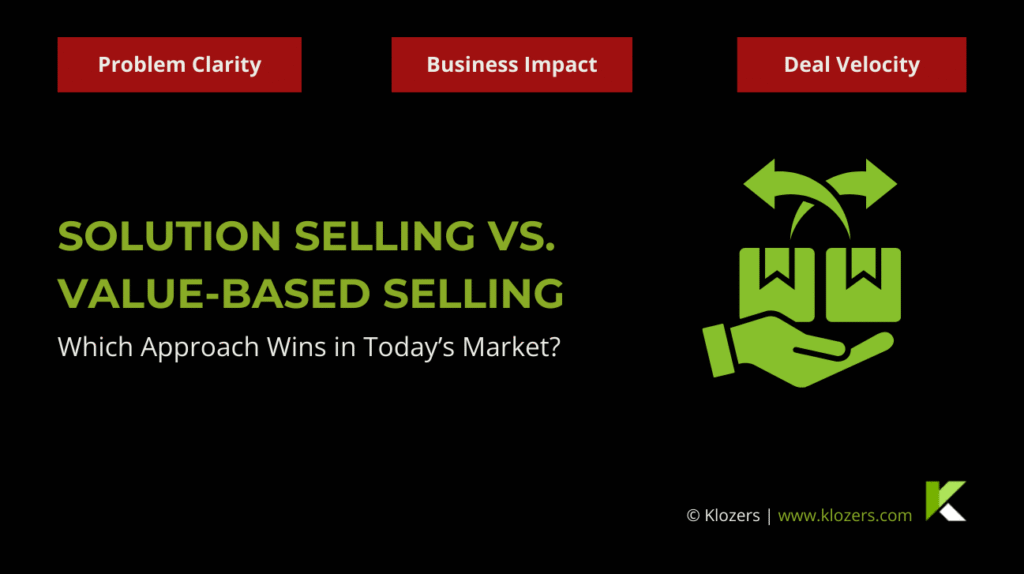Solution Selling vs. Value-Based Selling - Top Question From Google
What is the difference between value-based selling and solution selling?
Solution selling focuses on identifying customer problems and presenting solutions to address those challenges. Value-based selling, on the other hand, centers on showing measurable business value and ROI that customers will receive from your product or service. While solution selling asks, “What problems can we solve?” value-based selling asks, “What specific value can we deliver?”
Free access to our best tools and templates
Introduction: Solution Selling vs. Value-Based Selling
According to Forrester’s 2024 Marketing Survey, three-quarters of B2B marketers say buyers are taking longer to commit to a purchase than they did in 2023. This shift means sales teams need to be smarter about how they approach conversations with potential customers.
Solution selling and value-based selling have proven to be particularly effective in this environment. Both approaches move away from traditional product-focused pitches, but they take different paths to get there. Sales teams need to understand when to use each approach to close more deals easil

Understanding the Basics – What Each Approach Means
What is Solution Selling?
Solution selling is built around the idea that customers buy to solve problems, not to acquire products. This approach starts with discovery conversations where you uncover the challenges your prospect is facing. Instead of jumping straight into product features, you spend time understanding their pain points, current processes, and what’s not working in their business.
The methodology follows a clear progression. First, you qualify whether the prospect has problems you can solve. Then, you dig deep to understand those challenges and their impact on the business. After that, you present your offering as a complete solution that addresses their specific situation.
For example, let’s say you’re selling project management software to a marketing agency. Instead of starting with a demo of your tool’s features, you’d begin by asking about their current project workflow. You might discover they’re struggling with missed deadlines, poor communication between team members, and clients who feel left out of the process. Only after understanding these specific challenges would you show how your software addresses each pain point.
What is Value-Based Selling?
Value-based selling takes a different approach entirely. Instead of starting with problems, it starts with outcomes. This method focuses on the measurable business value your solution will deliver. That is, things like increased revenue, cost savings, improved efficiency, or faster time to market.
Value-based selling requires you to think like a business consultant. You need to understand how your product translates into bottom-line results for your customer. This means being able to quantify the impact of your solution in terms that matter to decision-makers.
Using the same marketing agency example, a value-based approach would focus on the financial impact of better project management. You might calculate that reducing project delays by 20% would save the agency $50,000 annually in rushed work and client penalties. Or you could show how improved efficiency would allow them to take on three additional clients per year without hiring new staff. The conversation becomes about ROI rather than software capabilities.
Key Differences Between Solution Selling vs. Value-Based Selling
The Sales Conversation
The most obvious difference between these approaches is how conversations unfold. Solution-selling conversations tend to be exploratory and diagnostic. In this case, the focus is on getting the prospect to acknowledge that they have issues that need fixing. You’re asking questions to identify problems and understand their implications.
These conversations often start with questions like: “What’s your biggest challenge with your current process?” or “How is this problem affecting your team’s productivity?” The goal is to create problem awareness.
Value-based selling conversations are more analytical and forward-looking. Instead of dwelling on problems, you quickly move to discussing outcomes and measuring potential impact. You might ask questions like: “What would a 25% improvement in efficiency be worth to your business?” or “How would faster project completion affect your client retention?”
For example, take a sales rep selling customer service software to a retail company. In solution selling, you’d spend time identifying their current customer service challenges, such as long wait times, frustrated customers, and overwhelmed support staff. You’d help them see how these problems hurt their business.
In value-based selling, you’d quickly acknowledge these challenges exist, then shift focus to the business impact of solving them. You might present data showing that companies with excellent customer service see 23% higher customer retention rates, translating to $2 million in additional annual revenue for a company of their size.
Buyer Engagement
The two approaches also engage buyers differently throughout the sales process. Solution selling tends to create more collaborative relationships because you’re working together to diagnose problems and design solutions. Prospects often appreciate feeling heard and understood, which builds trust and rapport.
However, this collaborative approach can sometimes slow down the sales process. Some buyers, particularly senior executives, don’t want to spend time discussing problems they already know exist. They want to see results and understand the business case for change.
Value-based selling meets this expectation by speaking directly to business outcomes that matter to decision-makers. It engages buyers by appealing to their desire for measurable results. This approach works particularly well with financially-oriented buyers who think in terms of ROI and business metrics.
Measurement of Success
How you measure success differs between the two approaches. Solution selling success is often measured by how well you’ve addressed the customer’s stated problems. Did you solve their pain points? Are they satisfied with the solution? Is the problem truly resolved?
Value-based selling success is measured in business metrics and the actual value delivered to the customer. This might include revenue increases, cost savings, productivity improvements, or other quantifiable benefits.
Strengths and Weaknesses of Each Approach
When Solution Selling Works Best
Solution selling is particularly effective when you’re dealing with complex, technical products where the buying process involves multiple stakeholders who need to understand exactly how your solution addresses their specific challenges.
This approach works well in industries where operational efficiency and problem-solving are top priorities. For example, if you’re selling manufacturing equipment, healthcare technology, or enterprise software, buyers often need to understand precisely how your solution will integrate with their existing processes and solve their operational challenges.
Solution selling also shines when you’re working with buyers who are early in their research process. These prospects may know they have problems but haven’t fully defined them or understood their implications. Your consultative approach helps them clarify their needs while positioning your solution as the answer.
When Value-Based Selling Delivers More Impact
Value-based selling is the stronger choice when you’re dealing with sophisticated buyers who clearly understand their challenges and want to focus on business outcomes. This approach works particularly well with senior executives and financial decision-makers who value ROI.
This approach is especially powerful when selling to companies facing competitive pressure or economic constraints. Instead of asking them to invest in solving problems, you’re asking them to invest in measurable business improvements. The conversation becomes about growth and competitive advantage rather than fixing what’s broken.
Final Thoughts
You don’t have to choose between solution selling and value-based selling and stick with it forever. The most successful sales professionals understand when to use each method and how to blend them effectively.
In many cases, you can even combine elements of both methodologies. You might start with solution selling to build rapport and understand the customer’s situation, then transition to value-based selling to quantify the business impact and create urgency around the decision.
The key is reading your buyer and understanding what motivates them. Some buyers want to feel heard and understood before they consider any solution. Others want to cut straight to the business case and understand what you can do for their bottom line. Your job is to adapt your approach to match their preferences and buying style.
ACTIONABLE TIP
Actionable Tip:
Train your sales team to use a dual-track conversation map — one path for uncovering problems (solution selling) and another for quantifying business impact (value-based selling). Switching tracks based on buyer preference keeps conversations relevant and maximises close rates.




